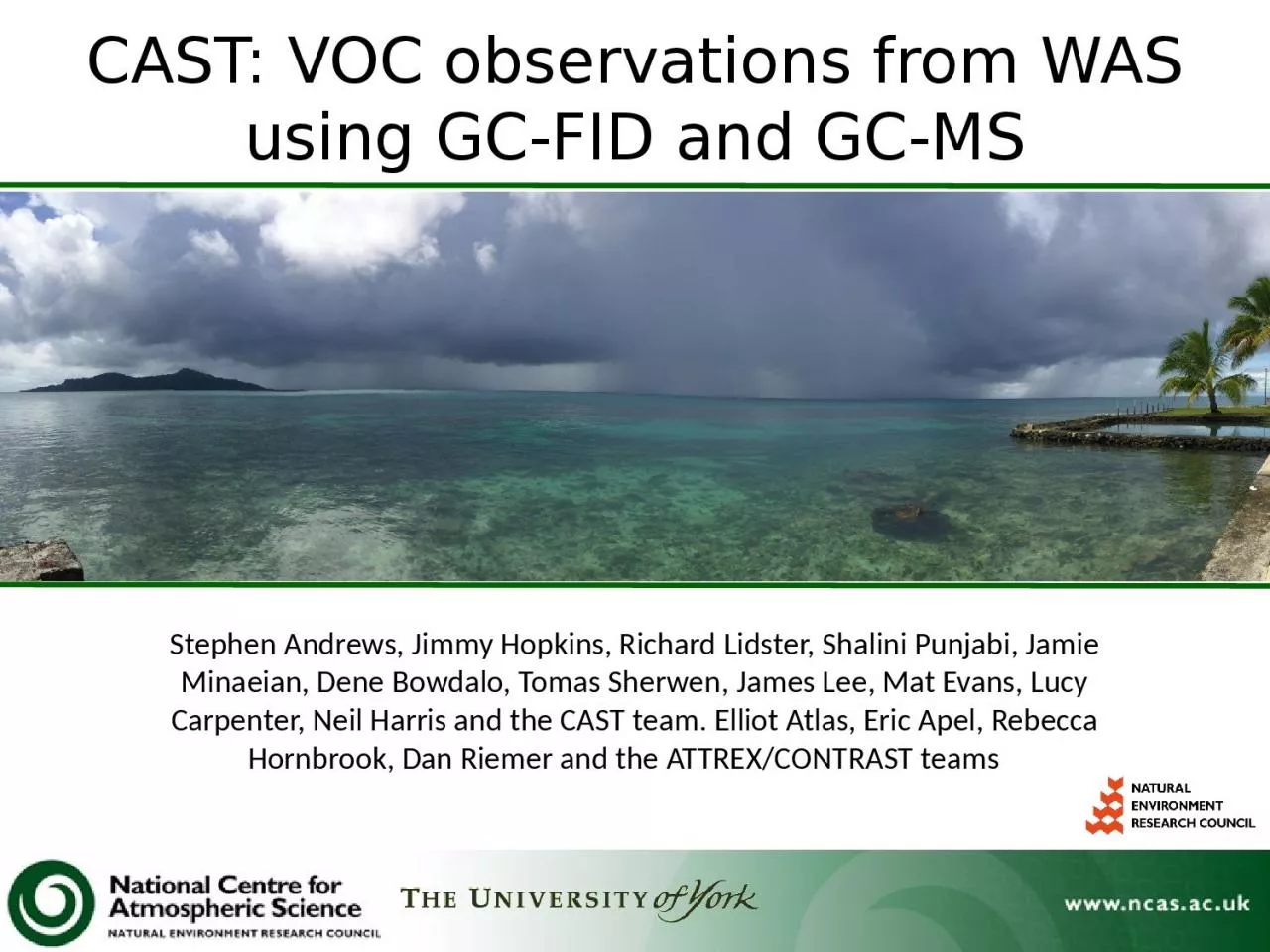

Stephen Andrews Jimmy Hopkins Richard Lidster Shalini Punjabi Jamie Minaeian Dene Bowdalo Tomas Sherwen James Lee Mat Evans Lucy Carpenter Neil Harris and the CAST ID: 1041870
Download Presentation The PPT/PDF document "CAST: VOC observations from WAS using GC..." is the property of its rightful owner. Permission is granted to download and print the materials on this web site for personal, non-commercial use only, and to display it on your personal computer provided you do not modify the materials and that you retain all copyright notices contained in the materials. By downloading content from our website, you accept the terms of this agreement.
1. CAST: VOC observations from WAS using GC-FID and GC-MSStephen Andrews, Jimmy Hopkins, Richard Lidster, Shalini Punjabi, Jamie Minaeian, Dene Bowdalo, Tomas Sherwen, James Lee, Mat Evans, Lucy Carpenter, Neil Harris and the CAST team. Elliot Atlas, Eric Apel, Rebecca Hornbrook, Dan Riemer and the ATTREX/CONTRAST teams
2. Whole air samples (WAS) taken from BAE-146 3 L SilcoSteel canisters evacuated and filled to ~30-40psi 620 samples analysed by GC-DCFID for NMHC and DMS 667 samples analysed by GC-MS for DMS and halogenated VSLSCalibration scales: NMHC on NPL/GAW scale DMS from primary KRISS standard Halocarbons on NOAA scaleIntercalibration: WAS (BAE-146), AWAS (GV/GH) and TOGA (GV) inter-calibrated using NOAA standard cylinder and a Miami Essex cylinder standard CAST VOC observations- sampling and calibration
3. CAST VOC observations- WAS sampling region
4. CAST VOC observations- WAS sampling region
5. CAST VOC observations – air mass characteristics In general, air masses appeared well-processed and representative of background. At source the ratio of toluene/benzene would be approximately 4.0
6. CAST VOC observations – CAST WAS sample spatial distribution No unusual concentrations in dataset Aimed to capture variation in surface concentration at maximum range Sample full vertical profile up to operational ceiling (~8 km)
7. CAST VOC observations acetylene (marker for anthropogenic pollution): fairly even distribution with perhaps decreased levels to the south and east and enhancements around Palau Concentrations compare well between platforms
8. CAST VOC observations – dimethyl sulphide (DMS) DMS highly variable due to short lifetime (~1day) and production mechanism DMS well characterised between CAST WAS instruments Compares well in vertical profile to AWAS (GV/GH)
9. CAST VOC observations - iodocarbons Iodocarbons quantified including CH3I, CH2ICl and CH2I2 CH2I2 mostly below limit of detection (LOD) CH2ICl mainly below 2 km Rapid photolysis in MBL/FT
10. CAST VOC observations – combined vertical profiles Combined WAS/AWAS dataset provides a balanced distribution of data throughout the vertical profile
11. CAST VOC observations - combined vertical profiles Some species show slight concentration offset which may get resolved using inter-calibration work
12. CAST VOC observations Combined datasets provide a comprehensive vertical profile Parameters such as O3, H2O and CO can be used to estimate the emission age/history Interception of aged, possibly entrained UTTL air at ~5-7 km
13. CAST VOC observations – bromoform vertical profile GeosChem output along GV and 146 flight track Over-estimates at the surface possibly vertical transport too
14. CAST VOC observations – Stratospheric bromine contribution GeosChem modelled profile reproduces vertical structure fairly wellCH2Br2 and CHBr3 contribute around 2-4 ppt to upper TTL as SG
15. CAST VOC observations – Anthropogenic influences? CH2Cl2 concentrations are increasing globally Very clear correlation between CHCl3 and CH2Cl2and correlation with anthropogenic tracers CH2Cl2 ~70% industrial source ~20% oceanic CHCl3 ~15% industrial source ~50% oceanic ~35% soil TORERO
16. SHIVAStratospheric Ozone:Halogen Impacts in a Varying AtmosphereNov-Dec 2011Sala, S. et al. 2014 Deriving an atmospheric budget of total organic bromine using airborne in situ measurements from the western Pacific area during SHIVA, ACPCAST VOC observations – SHIVA comparisonCH2Br2CHBr3
17. Model Developments for VSLS During CASTRobyn Butler (r.butler-2@sms.ed.ac.uk), Paul Palmer and Liang FengPrincipal modelling tool - GEOS-ChemCAST & CONTRAST measurements used to evaluate VSLS chemistry and transportPotential problem with oceanic fluxes of VSLS – positive model biasTracer:tracer ratio plots will be used to understand chemistry & transport over the regionTagged-VSLS Model Simulation to understand the role of different geographical emissions of VSLSTo be used in conjunction with inversion modelling to better estimate emission fluxesAir-sea flux formulation will be used to better represent seasonal & daily flux variations of VSLS emissions= Method to calculate the physical age of recent emissions over the region
18. CAST: VOC observations from WAS using GC-FID and GC-MSStephen Andrews, Jimmy Hopkins, Richard Lidster, Shalini Punjabi, Jamie Minaeian, Dene Bowdalo, James Lee, Mat Evans, Lucy Carpenter, Neil Harris and the CAST team. Elliot Atlas, Eric Apel, Rebecca Hornbrook, Dan Riemer and the ATTREX/CONTRAST teams
19.